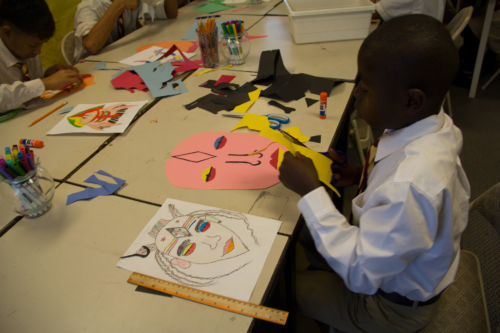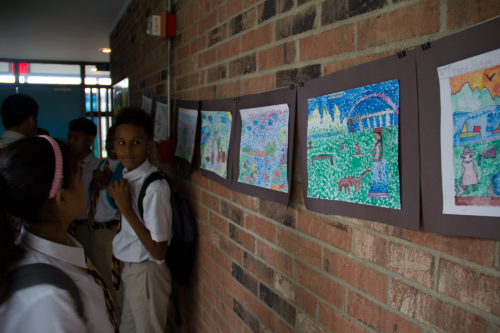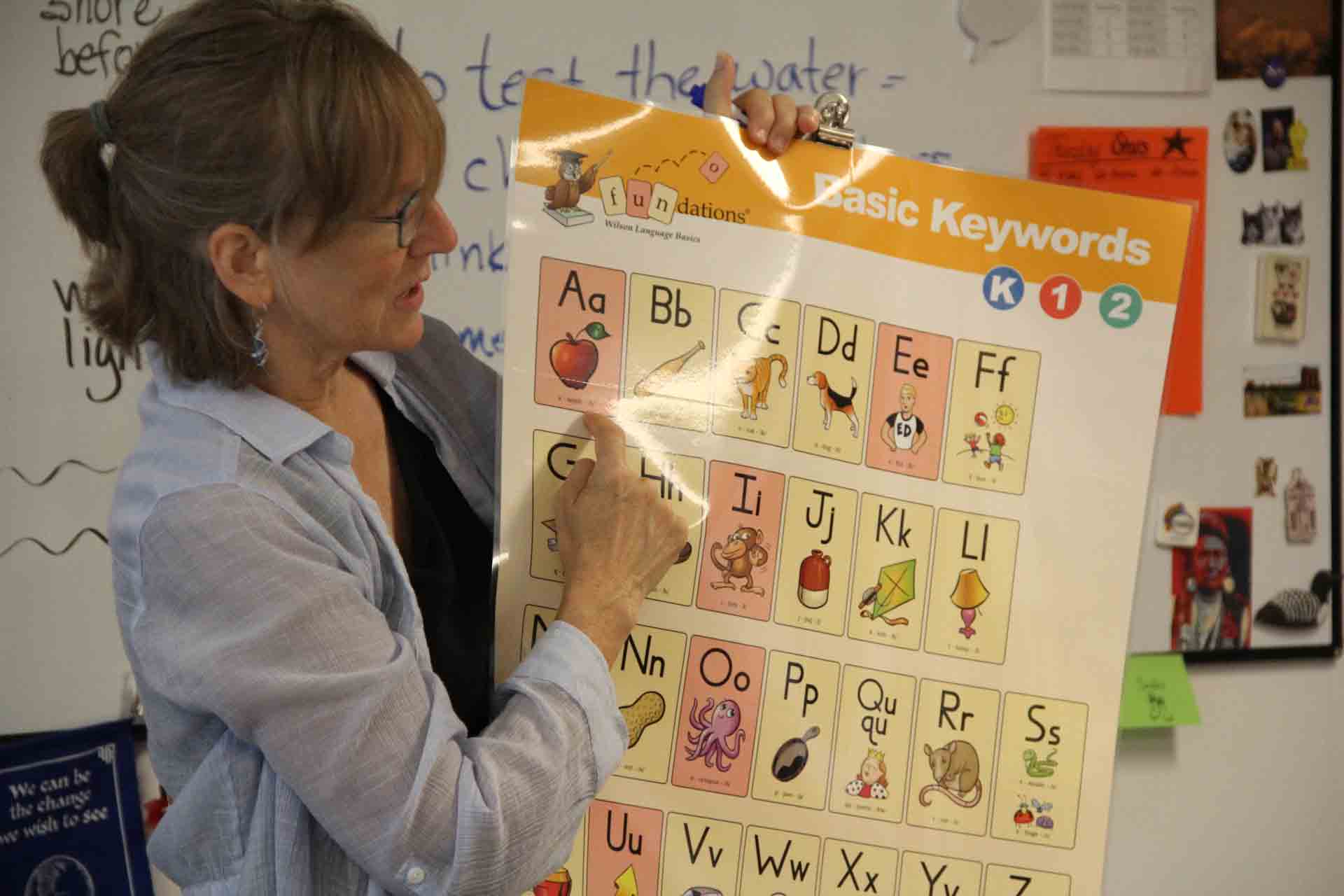School Network Takes Turbocharged Approach to Education for Refugee Students
Author: Ki Sung
Go to Source
This story about Fugees Academy was produced by The Hechinger Report, a nonprofit, independent news organization focused on inequality and innovation in education. Sign up for Hechinger’s newsletter.
COLUMBUS, Ohio — Mariam was on a roll. A bubbly sixth grader in a bright pink hijab, she sat in a semi-circle with her four classmates, trying to identify as many words with a long “a” vowel sound as she could.
“Rake,” she said.
“Rake — perfect,” Sharon George, her teacher, said encouragingly. “So, take your yellow marker and highlight the ‘a’ in rake.”
The English language, George told her students, is hard. The rules of pronunciation and grammar are complicated and full of exceptions. It can be difficult for students who’ve grown up in the United States — let alone those who’ve only just arrived after having their learning disrupted by war and conflict.
The students in George’s class are all refugees. Mariam came to the United States from Sudan. Her classmates are from Somalia, Syria, Burundi and Nepal. They have chosen this school, Fugees Academy, for its explicit focus on serving young refugee students and helping them through high school and into college.
Fugees Academy is perhaps the only school in the nation to enroll refugee students exclusively. It was founded on the belief that these learners need more focused attention than they often receive in traditional public schools, and that they need to go back to basics to learn English. Fugees (its name is a play on “refugees”) tries to squeeze in many of the elements of a K-8 curriculum into three years of middle school, helping students learn two to three years of the English language in one. The school also places an emphasis on helping students overcome trauma they may have faced on their journey to the United States.

The academy is tiny but growing. Its original Atlanta campus has 89 students and there are 42 at a new school in Columbus, Ohio, which opened last year. Two additional schools are in the works. Early results are encouraging: The Atlanta high school’s graduation rate is 92 percent and 74 percent of graduates have gone on to college, according to Luma Mufleh, its founder. And yet, the school is expanding at a moment when the political climate in the United States has grown increasingly hostile to refugees, adding to the social and emotional challenges of its students and elevating the need for the non-academic work the school specializes in.
“We do a lot of work of explaining what they are hearing and seeing and reassuring them that this country does want them and the bulk of America believes in them, but sometimes it’s hard,” Mufleh said.
Mufleh, whose mother was a Syrian refugee, grew up in Jordan, and moved to the United States for college in the early 1990s. In 2004, while working as a café owner near Atlanta, she stumbled on a group of boys playing soccer. She learned that they’d moved to the U.S. from countries like Afghanistan and Liberia. She began coaching them, founding a soccer program. Later, when she discovered that some of the boys were receiving good grades in school even though they couldn’t read English, she decided to start a school as well.

With help from private donors, she opened her first school in 2007 in the Atlanta suburbs. Serving grades 6 through 12, the private institution graduated 22 students in its first four years. Last year, Mufleh opened the Columbus school, offering classes for sixth grade only. The school will add a grade each year, with the goal of eventually growing to three times the size of the Atlanta school. Mufleh hopes to add a third school in Cleveland, Ohio in 2020; a second Georgia school recently won approval from the state. The newer schools are set up as public charter schools; the Ohio institutions will be funded primarily by a state voucher program.
Vouchers and charter schools are controversial because they draw money away from the traditional public school system, which educates the vast majority of U.S. students. But Mufleh said the private and charter models offer far more flexibility. Traditional public schools, for example, cannot focus exclusively on refugees, because they are not allowed to ask students about their immigration status over concerns it could lead to discrimination, said Julie Sugarman, a senior policy analyst at the nonprofit Migration Policy Institute.
Schools that cater to special populations like refugees can also educate students at grade levels that are years behind their age. Mufleh said that approach is key to helping refugee students achieve academically. Often, when refugee students arrive in the United States, they are placed temporarily in “newcomer centers” where they learn alongside similarly situated students for a period of time. Within six months or so, they are moved to regular classes. But the students are grouped by age, not by their skill-level, and teachers don’t have the time to help them catch up in English and other areas, Mufleh said.
Emily Futransky, chief academic officer of Fugees Family, the nonprofit that runs the academy, tries to identify instructional methods to help the school meet the educational needs of young refugees. Finding a curriculum that addresses the students’ skill level while acknowledging their age can be difficult. For example, the school uses phonics, an approach often geared toward elementary schoolers, to teach sixth graders to read. Futransky said the school has received pushback for her use of the early elementary method, which helps kids connect sounds to letters.
One source of criticism has come from the education company responsible for the phonics curriculum, Wilson Language Training’s Fundations, Futransky said. But she and her colleagues say the school has evidence that older kids can benefit from the K-3 program, too. “We meet the students where they are at,” said Mufleh, who noted that she’s seen kids who weren’t reading at age 11 or 12 advance several grade levels in a year. (In an email, Angela Penfold, senior director of strategic program development at Wilson, said, “The school will know best what is needed to teach its unique student population.”)

Sugarman said that the newcomer centers vary in quality, like all schools and programs. And she said that grouping refugee kids in their own school may be necessary, even though it could exacerbate their separation from other students. “We have such a shortage of teachers who understand how to do English language learner instruction that incorporates language development into academic content development,” she said. “I am more concerned with kids getting appropriate instruction, especially at the beginner levels, than I am about the fact that they’re being segregated.”
On a recent weekday, three staff members greeted students at the front doors of St. Andrew Presbyterian Church, the one-story building that houses the Fugees school. After saying hello to their teachers, the students hustled through the building’s brown doors and into the cafeteria where they ate breakfast and lined up according to their “house,” akin to an advisory group.
The school day runs from 8 a.m. to 6 p.m. It starts with yoga and ends with soccer practice and after-school tutoring. Fugees Academy runs year-round, with six weeks of summer programming. The idea is to pack in as much as possible so students have the opportunity to catch up with — and outpace — their peers.
Lewis Makor, 27, is the school’s co-leader for the Columbus campus. A Sudanese refugee with a calm, warm disposition, he was among the first six students to attend the Atlanta school when it opened in 2007. Back then, Fugees only offered classes for middle school students, so after he finished eighth grade, Makor attended high school at his neighborhood public school. He went to college for two years, but dropped out and struggled to hold a job. Mufleh called him last year and told him she needed his help for the new school.
Mufleh said she makes a point of hiring Fugees graduates and other refugees. She wants students to be able to see people who look like them in positions of authority. About 30 percent of Fugees’ employees are foreign-born.
One recent weekday in Columbus, students twisted into different positions as Kassandra Young, the school’s yoga instructor, led them through each move, reminding them to inhale and exhale. Yoga gives students time for self-reflection, which is vital for students who’ve faced trauma, she explained.
In arts class, teachers encourage students to present their projects and critique each other’s work. That helps students develop communication skills and the ability to interact with each other, teachers here said. Fugees Academy also helps celebrate students’ cultural identities by holding monthly potlucks and integrating books from different cultures into the curriculum (students are reading Middle Eastern and South Korean versions of Little Red Riding Hood, for example). Accents are celebrated rather than being seen as something to poke fun at. Each afternoon students gather in the cafeteria for “accountability time,” where they share news about the day and process what’s gone right and wrong.
“Academic achievement is important for us, but it’s also about belonging and integration and our students making sense of this new country,” said Mufleh.
Each summer, Mufleh and her staff make a push to recruit new students. They go into neighborhoods and knock on doors. Some of the students they enroll have just arrived from abroad, while others have spent years in U.S. schools.
Manjil, a 13-year-old from Nepal, enrolled in Fugees Academy after three years at a traditional public school that focuses on English language learners. When he started at Fugees, he was still reading at roughly a kindergarten level.
He said he didn’t take his classes seriously and often got in trouble. At first, he got in trouble at the academy, too. Once he threw wet toilet paper at a teacher.
“When I first came to school, I was frustrated,” he said. “School was like a joke to me.”
But Manjil said he gradually grew more motivated. He began to embrace the responsibilities the school gives it students, such as helping tidy classrooms and the school grounds. Now, he even enjoys helping his mom clean their house, he said.
The Trump administration’s anti-refugee policies have complicated the work of the school and the lives of its students. Since 2016, the government has drastically reduced the number of refugees resettled in the United States. That year, the United States admitted nearly 85,000 refugees; next year it will admit 18,000, an historic low.
Mufleh said she is optimistic that those cuts won’t dim the school’s future. Atlanta, Columbus and Cleveland all have significant refugee populations and are expected to remain hubs for resettlement, she said.
But many Fugees Academy students are painfully aware of the anti-refugee sentiment that often bubbles up, particularly on social media. Mufleh recalled a student texting her a picture of a flyer circulating online that threatened harm to Muslims.
“It’s tough on our staff and our faculty and team that are on the frontlines; they bear the brunt of that,” said Mufleh. “You have to stay in control most of the time and present the united front and not fly off the handle on what’s going on.”
It’s grown harder to gain the trust of parents, too, school leaders said. That’s where the employees’ diversity comes into play: Often staff can speak directly with prospective parents in their native tongues and help them feel comfortable. According to Mufleh, just 15 percent of students’ parents have finished middle school.
In George’s sixth grade classroom, students finished up their phonics lesson. George has taught English for 19 years in public schools. Never has she been so mindful of just how fast her students need to learn and how far they need to go, she said.
“Every minute,” she said, “has to count.”
This story about Fugees Academy was produced by The Hechinger Report, a nonprofit, independent news organization focused on inequality and innovation in education. Sign up for Hechinger’s newsletter.
